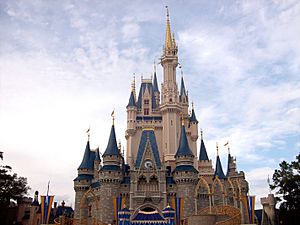Economy of Florida facts for kids
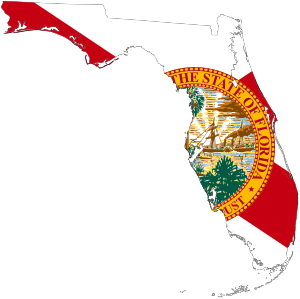 |
|
| Statistics | |
|---|---|
| GDP | $1.2 trillion (2021) |
|
GDP per capita
|
$56,301 (2021) |
| Unemployment | 3.2% (March 2022) |
The economy of the state of Florida is the fourth-largest in the United States, with a $1.2 trillion gross state product (GSP) as of 2021. If Florida were a sovereign nation (2021), it would rank as the world's 16th-largest economy according to the International Monetary Fund, ahead of Indonesia and behind Mexico. In the 20th century, tourism, industry, construction, international banking, biomedical and life sciences, healthcare research, simulation training, aerospace and defense, and commercial space travel have contributed to the state's economic development.
Contents
Overview
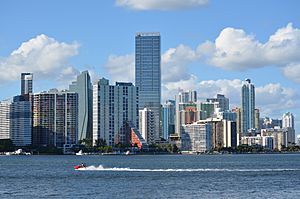
Florida's economy ranks among the largest in the world. As of 2021, the gross state product (GSP) is about $1.2 trillion, the fourth largest economy in the United States. Florida is responsible for 5.23% of the United States' approximately $21 trillion gross domestic product (GDP). As of 2021[update], Florida's nominal GDP is larger than all but 15 countries; if it were a sovereign nation, it would be ranked ahead of Indonesia and behind Mexico. In terms of Purchasing Power Parity, it is larger than all but 24 countries. In the 20th century, tourism, industry, construction, international banking, biomedical and life sciences, healthcare research, simulation training, aerospace and defense, and commercial space travel have contributed to the state's economic development.
The five largest sectors of employment in Florida are: trade, transportation, and utilities; government; professional and business services; education and health services; and leisure and hospitality. In output, the five largest sectors are: finance, insurance, real estate, rental, and leasing, followed by professional and business services; government and government enterprises; educational services, health care, and social assistance; and retail trade.
In 2017, Florida became the United States' eighth largest exporter of trade goods. Florida's top countries for export are Brazil, Canada, Mexico, Germany, and Colombia. In 2017, Florida became the United States' tenth largest importer of trade goods. Florida imported US$75.4 billion worth of goods globally in 2017. The value of Florida's imports equals 3.2% of United States' overall imported products for 2017. Florida's top countries for imports are China, Mexico, Canada, Germany, and France.
The Miami Metropolitan Area has the highest GDP of all the metro areas in Florida with $344.9 billion in 2017. This is more than twice the number of the next metro area, the Tampa Bay Area, which has a GDP of $145.3 billion. The economy of Florida is driven almost entirely by its nineteen metropolitan areas. In 2004, they had a combined total of 95.7% of the state's domestic product.
Per capita GDP in 2017 was $39,842, ranking 40th in the nation. Per capita income varies widely by geographic region and profession. North Florida and the rural counties of the Florida Panhandle are the most impoverished in the state. Florida has a poverty rate of 14.0%, the seventeenth lowest of any state in the country. Many coastal cities include some of the wealthiest per-capita areas in the United States.
In 2018, there were more than 427,824 millionaires in the state, the fourth-highest number in the nation.
For 2018–19, the approved state budget is $88.7 billion, a 4.4% increase over the previous 2017–18 budget of $84.9 billion. Chief Executive Magazine named Florida the third "Best State for Business" in 2011.
Personal income
In 2017, Florida's per capita personal income was $47,684, ranking 26th in the nation. The state's unemployment rate in September 2018 was 3.5% and ranked as the 18th lowest in the United States. Florida is one of seven states that does not impose a personal income tax.
In 2017, Florida had a personal income of $1,000,624,065 (in thousands of dollars). This personal income ranked 4th in the United States.
Florida's constitution establishes a state minimum wage, which is adjusted annually for inflation. As of September 30, 2021[update], Florida's minimum wage was $6.98 for tipped positions, and $10.00 for non-tipped positions, which was higher than the federal rate of $7.25. The wage will increase by $1 per hour yearly, until 2026 when the minimum wage for non-tipped positions will reach $15 per hour.
Florida has two cities in the top 25 cities in the U.S. with the highest average credit card debt, Miami and Tampa.
The poverty rate in Florida in 2018 was 14%, down from a peak of 17.1% in 2012.
Sectors
Agriculture
Agriculture is the second largest industry in the state. Florida was ranked in 2019, "first in the value of production for bell peppers for fresh market, grapefruit, oranges, sugarcane, fresh market tomatoes, and watermelons" in the United States according to Florida Agriculture by the Numbers. In 2002 peppers and tomatoes were #1 and #2 in dollar value for the state and citrus fruit, especially oranges, were also a major part of the economy – by 2019 tomatoes were #1, oranges #2, and peppers were #3. Of exports, meat is Florida's biggest earner. Florida produces the majority of citrus fruit grown in the United States.
Although citrus cultivation also began here in the 1500s, commercial scale production was only attempted in the 1920s. At first this went badly due to severe pest and disease epidemics, which were themselves due to poor understanding of the local climate and terrain. As of 2019[update] oranges make up 93% of Florida's citrus production, followed by 6% for grapefruit, and 1% for tangerines and tangelos. For 2018, 10.9% of all cash receipts were citruses. In 2006, 67% of all citrus, 74% of oranges, 58% of tangerines, and 54% of grapefruit were grown in Florida. About 95% of commercial orange production in the state is destined for processing (mostly as orange juice, the official state beverage). The top 5 citrus-producing counties, according to data in 2019, was "DeSoto (12.8 million boxes), Polk (12.5 million boxes), Highlands (10.8 million boxes), Hendry (10.5 million boxes) and Hardee (8.16 million boxes)", according to Florida Agriculture by the Numbers. Together they contribute 71% of Florida's total citrus production. The Central produced the most citrus, followed by the Western area and the Southern areas. International citrus fresh fruit exports totaled to "2.05 million 4/5 bushel cartons", and Japan received the majority of the grapefruit exports. Canada received most of Florida's orange and tangerine exports. Florida Agriculture by the Numbers reports "4.70 million gallons of Frozen Concentrated Orange Juice (FCOJ), and 0.38 million gallons of Frozen Concentrated Grapefruit Juice (FCGJ) was exported in the 2018–2019 season".
The largest farm category by sales in Florida is the $2.3 billion ornamental industry, which includes nursery, greenhouse, flowers, and sod products.
Other products include sugarcane, strawberries, tomatoes and celery. The state is the largest producer of sweet corn and green beans for the U.S.
Peaches have probably been grown here since the 1500s, brought by the Spanish. By the late 1700s an export trade had developed with the mid-Atlantic states, with Baltimore the first hub to distribute Florida peaches into the surrounding region.
The Everglades Agricultural Area is a major center for agriculture. The environmental impact of agriculture, especially water pollution, is a major issue in Florida today.
The state has a near monopoly on saw palmetto berries, an alternative medicine used to treat prostate and urinary disorders.
Pests and diseases
Citrus canker (Xanthomonas axonopodis) continues to be an issue of concern. From 1997 to 2013, the growing of citrus trees has declined 25%, from 600,000 to 450,000 acres (240,000 to 180,000 ha). Citrus greening disease is incurable. A study states that it has caused the loss of $4.5 billion between 2006 and 2012. As of 2014[update], it was the major agricultural concern. Results of the annual Commercial Citrus Inventory showed that citrus acreage in 2019 was down 4% than 2018 and was the lowest in a series that began in 1966. There was a net loss of 16,411 acres during the 2018–2019 season and was twice what was lost in the previous season. Of a survey conducted of 25 published counties, 24 of them, or 96% recorded decrease in acreage. Only Sarasota County showed an increase in acreage during the 2018–2019 season. Other major citrus concerns include citrus root weevil Diaprepes abbreviatus, the citrus leafminer Phyllocnistis citrella, and the Asian citrus psyllid Diaphorina citri.
Tomato, bell pepper, and strawberry were the largest users of methyl bromide and so the phase out has required hard choices for alternative soil fumigants. A methyl iodide/chloropicrin mix has served well, producing equal performance to MB in pepper.
The Spotted Wing Drosophila (Drosophila suzukii) is a threat to blueberry, peach, cherry, strawberry, raspberry, and blackberry here. D. suzukii was introduced to much of North America from its initial introduction to California, including to this state.
Fishing
In 2009, fishing was a $6 billion industry, employing 60,000 jobs for sports and commercial purposes. Florida aquaculture producers reported sales in 2018 of $72 million, according to a survey administered by the Florida Agricultural Statistics Service.
Mass media
Broadband Internet in Florida is deployed by both government agencies and private companies. Examples of government agencies include the North Florida Broadband Authority.
Mining
Phosphate mining, concentrated in the Bone Valley, is the state's third-largest industry. The state produces about 75% of the phosphate required by farmers in the United States and 25% of the world supply, with about 95% used for agriculture (90% for fertilizer and 5% for livestock feed supplements) and 5% used for other products.
After the watershed events of Hurricane Andrew in 1992, Florida began investing in economic development through the Office of Trade, Tourism, and Economic Development. Governor Jeb Bush realized that watershed events such as Andrew negatively impacted Florida's backbone industry of tourism severely. The office was directed to target Medical/Bio-Sciences among others. Three years later, The Scripps Research Institute (TSRI) announced it had chosen Florida for its newest expansion. In 2003, TSRI announced plans to establish a major science center in Palm Beach, a 364,000 square feet (33,800 m2) facility on 100 acres (40 ha), which TSRI planned to occupy in 2006.
Real estate
In the early 20th century, land speculators discovered Florida, and businessmen such as Henry Plant and Henry Flagler developed railroad systems, which led people to move in, drawn by the weather and local economies. From then on, tourism boomed, fueling a cycle of development that overwhelmed a great deal of farmland.
At the end of the third quarter of 2008, Florida had the highest mortgage delinquency rate in the U.S., with 7.8% of mortgages delinquent at least 60 days. A 2009 list of national housing markets that were hard hit in the real estate crash included a disproportionate number in Florida. The early 21st-century building boom left Florida with 300,000 vacant homes in 2009, according to state figures. In 2009, the US Census Bureau estimated that Floridians spent an average 49.1% of personal income on housing-related costs, the third-highest percentage in the U.S.
In the third quarter of 2009, there were 278,189 delinquent loans, 80,327 foreclosures. Sales of existing homes in February 2010 was 11,890, up 21% from the same month in 2009. Only two metropolitan areas showed a decrease in homes sold: Panama City and Brevard County. The average sales price for an existing house was $131,000, 7% decrease from the prior year.
Seaports and boating
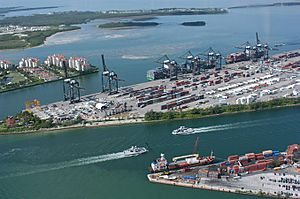
Florida has many seaports that serve container ships, tank ships, and cruise lines. Major ports in Florida include Port Tampa Bay in Tampa, Port Everglades in Fort Lauderdale, Port of Jacksonville in Jacksonville, PortMiami in Miami, Port Canaveral in Brevard County, Port Manatee in Manatee County, and Port of Palm Beach in Riviera Beach. The world's top three busiest cruise ports are found in Florida with PortMiami as the busiest and Port Canaveral and Port Everglades as the second and third busiest. Port Tampa Bay meanwhile is the largest in the state, having the most tonnage. As of 2013[update], Port Tampa Bay ranks 16th in the United States by tonnage in domestic trade, 32nd in foreign trade, and 22nd in total trade. It is the largest, most diversified port in Florida, has an economic impact of more than $15.1 billion, and supports more than 80,000 jobs.
Florida is the leading state for sales of powerboats. Boats sales totaled $1.96 billion in 2013.
Tourism
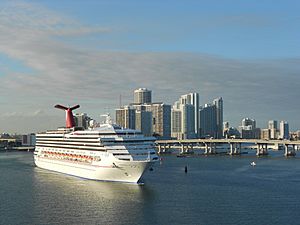

If you can't find something to do in Florida, you're just boring ...
—Guy Fieri, celebrity chef, 2017
Tourism makes up one of the largest sectors of the state economy, with nearly 1.4 million people employed in the tourism industry in 2016 (a record for the state, surpassing the 1.2 million employment from 2015).
In 2015, Florida broke the 100-million visitor mark for the first time in state history by hosting a record 105 million visitors. The state has set tourism records for eight consecutive years, most recently breaking the 120-million visitor mark for the first time in 2018 with 126.1 million visitors reported.
Many beach towns are popular tourist destinations, particularly during winter and spring break. Twenty-three million tourists visited Florida beaches in 2000, spending $22 billion. The public has a right to beach access under the public trust doctrine, but some areas have access effectively blocked by private owners for a long distance.
Data released shows 30.9 million visitors coming to the state from October to December of 2021, up nearly 60% from the same period in 2020 and topping pre-pandemic levels from the same quarter pre-pandemic.
Amusement parks, especially in the Greater Orlando area, make up a significant portion of tourism. The Walt Disney World Resort is the most visited vacation resort in the world with more than 58 million visitors annually, consisting of four theme parks, 27 themed resort hotels, nine non-Disney hotels, two water parks, four golf courses and other recreational venues. Other major theme parks in the area include Universal Orlando Resort, SeaWorld Orlando and Busch Gardens Tampa.
Florida's many state parks and protected areas receive a lot of visitors as well with 25.2 million visitors visiting Florida State Parks in 2013.
See also
 In Spanish: Economía de Florida para niños
In Spanish: Economía de Florida para niños



